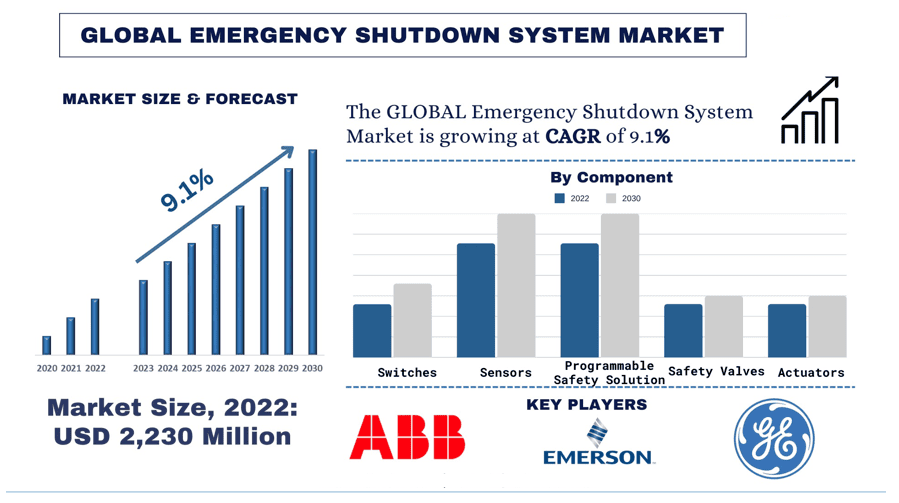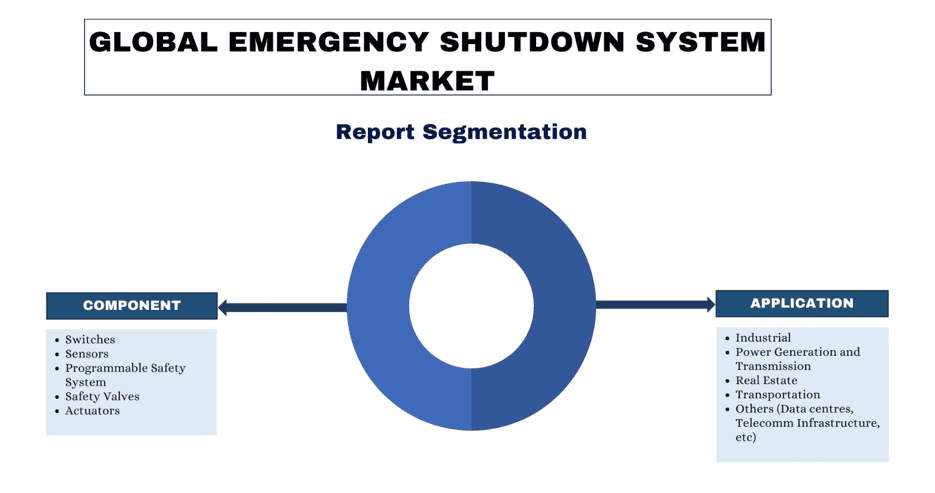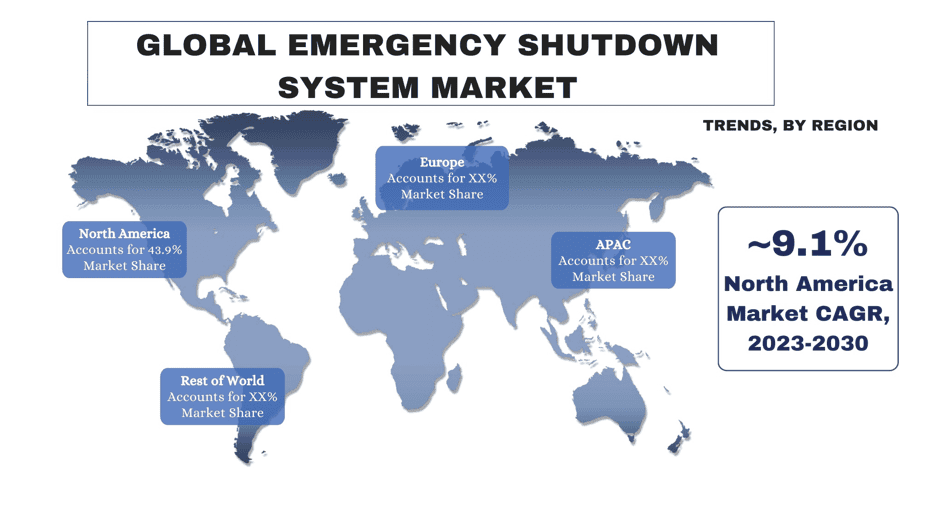Emergency Shutdown System Market: Current Analysis and Forecast (2023-2030)
Emphasis on Component (Switches, Sensors, Programmable Safety Systems, Safety Valves, and Actuators); Control Method (Pneumatic, Electrical, Fiber Optics, and Radio Telemetry); Application (Industrial, Power Generation and Transmission, Real Estate, Transportation, and Others); and Region/Country

Emergency Shutdown System Market Forecast & Size
The emergency shutdown system market was valued at USD 2,230 Million and is expected to grow at a strong CAGR of around 9.1% during the forecast period (2023-2030) owing to growing manufacturing process complexity and surging use of electrical components across various industries.
Emergency Shutdown System Market Analysis
An Emergency Shutdown System (ESD) is a critical safety instrumented system designed to bring a process plant or facility to a safe state in the event of an emergency or abnormal situation. The primary purpose of an ESD system is to protect personnel, equipment, and the environment from hazardous conditions such as fires, explosions, toxic releases, or other catastrophic events. At its core, an ESD system consists of sensors, logic solvers, and final control elements that work together to detect abnormal conditions and initiate actions to mitigate the risks associated with those conditions.
As industries continue to grapple with increasingly complex operations and stringent safety regulations, the demand for advanced ESD solutions is witnessing a remarkable surge. Industries are subject to rigorous safety regulations and standards imposed by governing bodies to mitigate the risk of catastrophic incidents. Failure to comply with these regulations can result in severe penalties, legal repercussions, and reputational damage. Emergency shutdown systems play a pivotal role in ensuring compliance by providing a failsafe mechanism to rapidly shut down operations in emergencies, preventing escalation and minimizing potential consequences. Furthermore, as industrial operations become more intricate and technologically advanced, the potential for system failures and hazardous situations escalates. ESD systems act as a crucial safeguard, enabling industries to swiftly respond to emergencies and mitigate the impact of such incidents. The oil and gas industry, for instance, has witnessed a surge in the adoption of ESD systems due to the inherent risks associated with upstream, midstream, and downstream operations. Factors such as these are fostering a conducive environment, and encouraging the widespread adoption of emergency shutdown systems across various markets worldwide.

Emergency Shutdown System Market Trends
This section discusses the key market trends that are influencing the various segments of the Emergency Shutdown System Market as identified by our team of research experts.
Power Generation & Transmission Stands Out as a Predominant Segment in Terms of Revenue Generation for Emergency Shutdown Systems Worldwide
The Power Generation and Transmission segment holds a predominant share of the emergency shutdown system industry. Primarily driven by the critical nature of the infrastructure. The power generation and transmission sector is considered a critical infrastructure due to its role in providing electricity, a vital resource for various other industries and daily life activities. Furthermore, power plants, and transmission systems involve high-voltage equipment and hazardous operations, increasing the risk associated with accidents or equipment failures, necessitating robust safety measures like ESD systems. Moreover, power generation and transmission assets are high-value investments that need protection against damage or operational failures. ESD systems play a crucial role in quickly isolating faults and preventing widespread damage, thus safeguarding investments. Additionally, The complexity of power generation plants and transmission networks, involving multiple interconnected systems and equipment, heightens the need for effective emergency shutdown mechanisms to manage emergencies efficiently and prevent cascading failures, thus making the emergency shutdown systems a very crucial component, ensuring continuous operation of the power generation and transmission infrastructure.

North America Holds the Major Portion of the Emergency Shutdown System market worldwide.
Within North America, the United States holds a major share of the market. The major factor boosting the market’s growth is the country’s established industrial infrastructure, particularly the Oil & Gas industry.
The North American region offers the largest market potential for the emergency shutdown system worldwide. North America, particularly the United States, has a stringent regulatory environment that places a strong emphasis on safety across various industries, including oil and gas, chemical, and power generation. These regulations mandate the implementation of robust safety systems, such as emergency shutdown systems, to mitigate risks and protect workers, assets, and the environment. Compliance with these regulations is a significant driver for the adoption of emergency shutdown systems in this region. Furthermore, North America is home to numerous major players in the emergency shutdown system industry, including renowned manufacturers, system integrators, and service providers. These companies have extensive experience and expertise in developing and deploying advanced emergency shutdown systems for various applications. Their presence and continuous innovation have contributed significantly to the growth of the market in this region. Additionally, the oil and gas industry is a significant consumer of emergency shutdown systems, and North America has a well-established and mature oil and gas sector. The region is home to numerous upstream, midstream, and downstream operations, all of which require robust safety measures, including emergency shutdown systems. The demand for these systems is driven by the need to ensure the safe and efficient operation of oil and gas facilities. These advances among others are primary factors fostering a conducive environment for the adoption of emergency shutdown systems in North America.
Emergency Shutdown System Industry Overview
The emergency shutdown system market is competitive and fragmented, with the presence of several global and international market players. The key players are adopting different growth strategies to enhance their market presence, such as partnerships, agreements, collaborations, new product launches, geographical expansions, and mergers and acquisitions. Some of the major players operating in the market are ABB; Emerson Electric Co.; General Electric Company; Honeywell International Inc.; Siemens; Schneider Electric; Rockwell Automation; Yokogawa Electric Corporation; OMRON Corporation; and Proserv UK Ltd
Emergency Shutdown System Market News
- In September 2023, Advanced RF Technologies, Inc. (ADRF) introduced its Emergency Power Off (EPO) Switch designed specifically for public safety repeaters (PSR). This solution addresses the growing need for Emergency Power Off capability in Emergency Responder Communication Enhancement Systems (ERCES) installations across various counties in the United States.
- For instance, in Jan 2022, Repsol chose Honeywell to provide an integrated control and safety system (ICSS) for Spain’s inaugural advanced biofuels project, as announced by Honeywell.
Emergency Shutdown System Market Report Coverage

Reasons to buy this report:
- The study includes market sizing and forecasting analysis validated by authenticated key industry experts.
- The report presents a quick review of overall industry performance at one glance.
- The report covers an in-depth analysis of prominent industry peers with a primary focus on key business financials, product portfolios, expansion strategies, and recent developments.
- Detailed examination of drivers, restraints, key trends, and opportunities prevailing in the industry.
- The study comprehensively covers the market across different segments.
- Deep dive regional level analysis of the industry.
Customization Options:
The global Emergency Shutdown System market can further be customized as per the requirement or any other market segment. Besides this, UMI understands that you may have your own business needs, hence feel free to contact us to get a report that completely suits your requirements.
Table of Contents
Research Methodology for the Emergency Shutdown System Market Analysis (2023-2030)
Analyzing the historical market, estimating the current market, and forecasting the future market of the global Emergency Shutdown System market were the three major steps undertaken to create and analyze the adoption of Emergency Shutdown System in major regions globally. Exhaustive secondary research was conducted to collect the historical market numbers and estimate the current market size. Secondly, to validate these insights, numerous findings and assumptions were taken into consideration. Moreover, exhaustive primary interviews were also conducted, with industry experts across the value chain of the global Emergency Shutdown System market. Post assumption and validation of market numbers through primary interviews, we employed a top-down/bottom-up approach to forecasting the complete market size. Thereafter, market breakdown and data triangulation methods were adopted to estimate and analyze the market size of segments and sub-segments of the industry pertains to. Detailed methodology is explained below:
Analysis of Historical Market Size
Step 1: In-Depth Study of Secondary Sources:
A detailed secondary study was conducted to obtain the historical market size of the Emergency Shutdown System market through company internal sources such as annual reports & financial statements, performance presentations, press releases, etc., and external sources including journals, news & articles, government publications, competitor publications, sector reports, third-party database, and other credible publications.
Step 2: Market Segmentation:
After obtaining the historical market size of the Emergency Shutdown System market, we conducted a detailed secondary analysis to gather historical market insights and share for different segments & sub-segments for major regions. Major segments are included in the report as components, control methods, and applications. Further country-level analyses were conducted to evaluate the overall adoption of testing models in that region.
Step 3: Factor Analysis:
After acquiring the historical market size of different segments and sub-segments, we conducted a detailed factor analysis to estimate the current market size of the Emergency Shutdown System market. Further, we conducted factor analysis using dependent and independent variables such as components, control methods, and applications of the Emergency Shutdown System market. A thorough analysis was conducted of demand and supply-side scenarios considering top partnerships, mergers and acquisitions, business expansion, and product launches in the Emergency Shutdown System market sector across the globe.
Current Market Size Estimate & Forecast
Current Market Sizing: Based on actionable insights from the above 3 steps, we arrived at the current market size, key players in the global Emergency Shutdown System market, and market shares of the segments. All the required percentage shares split and market breakdowns were determined using the above-mentioned secondary approach and were verified through primary interviews.
Estimation & Forecasting: For market estimation and forecast, weights were assigned to different factors including drivers & trends, restraints, and opportunities available for the stakeholders. After analyzing these factors, relevant forecasting techniques i.e., the top-down/bottom-up approach were applied to arrive at the market forecast for 2030 for different segments and sub-segments across the major markets globally. The research methodology adopted to estimate the market size encompasses:
- The industry’s market size, in terms of revenue (USD) and the adoption rate of the Emergency Shutdown System market across the major markets domestically
- All percentage shares, splits, and breakdowns of market segments and sub-segments
- Key players in the global Emergency Shutdown System market in terms of products offered. Also, the growth strategies adopted by these players to compete in the fast-growing market.
Market Size and Share Validation
Primary Research: In-depth interviews were conducted with the Key Opinion Leaders (KOLs) including Top Level Executives (CXO/VPs, Sales Head, Marketing Head, Operational Head, Regional Head, Country Head, etc.) across major regions. Primary research findings were then summarized, and statistical analysis was performed to prove the stated hypothesis. Inputs from primary research were consolidated with secondary findings, hence turning information into actionable insights.
Split of Primary Participants in Different Regions

Market Engineering
The data triangulation technique was employed to complete the overall market estimation and to arrive at precise statistical numbers for each segment and sub-segment of the global Emergency Shutdown System market. data was split into several segments & sub-segments after studying various parameters and trends in the areas of components, control methods, and applications in the global Emergency Shutdown System market.
The main objective of the Global Emergency Shutdown System Market Study
The current & future market trends of the global Emergency Shutdown System market were pinpointed in the study. Investors can gain strategic insights to base their discretion for investments on the qualitative and quantitative analysis performed in the study. Current and future market trends determined the overall attractiveness of the market at a regional level, providing a platform for the industrial participant to exploit the untapped market to benefit from a first-mover advantage. Other quantitative goals of the studies include:
- Analyze the current and forecast market size of the Emergency Shutdown System market in terms of value (USD). Also, analyze the current and forecast market size of different segments and sub-segments.
- Segments in the study include areas of components, control methods, and applications.
- Define and analyze the regulatory framework for the Emergency Shutdown System
- Analyze the value chain involved with the presence of various intermediaries, along with analyzing customer and competitor behaviors of the industry
- Analyze the current and forecast market size of the Emergency Shutdown System market for the major region
- Major countries of regions studied in the report include Asia Pacific, Europe, North America, and the Rest of the World
- Company profiles of the Emergency Shutdown System market and the growth strategies adopted by the market players to sustain in the fast-growing market.
- Deep dive regional level analysis of the industry
Frequently Asked Questions FAQs
Q1: What is the current market size and growth potential of the global Emergency Shutdown System market?
Q2: What are the driving factors for the growth of the global Emergency Shutdown System Market?
Q3: Which segment is the fastest growing of the global Emergency Shutdown System market by End-Users?
Q4: What are the emerging technologies and trends in the global Emergency Shutdown System market?
Q5: Which region will be the fastest-growing global Emergency Shutdown System market?
Q6: Who are the key players in the global Emergency Shutdown System market?
Related Reports
Customers who bought this item also bought










